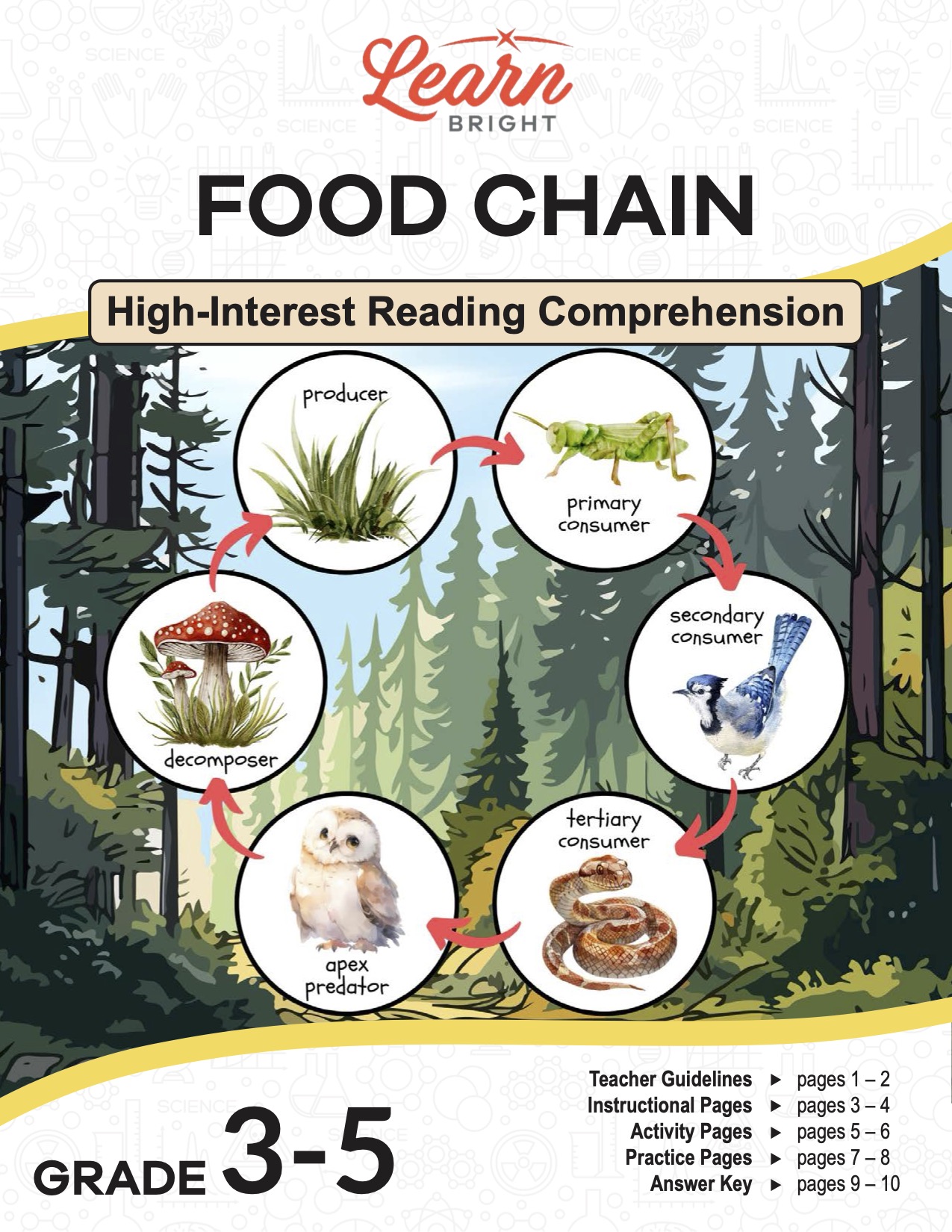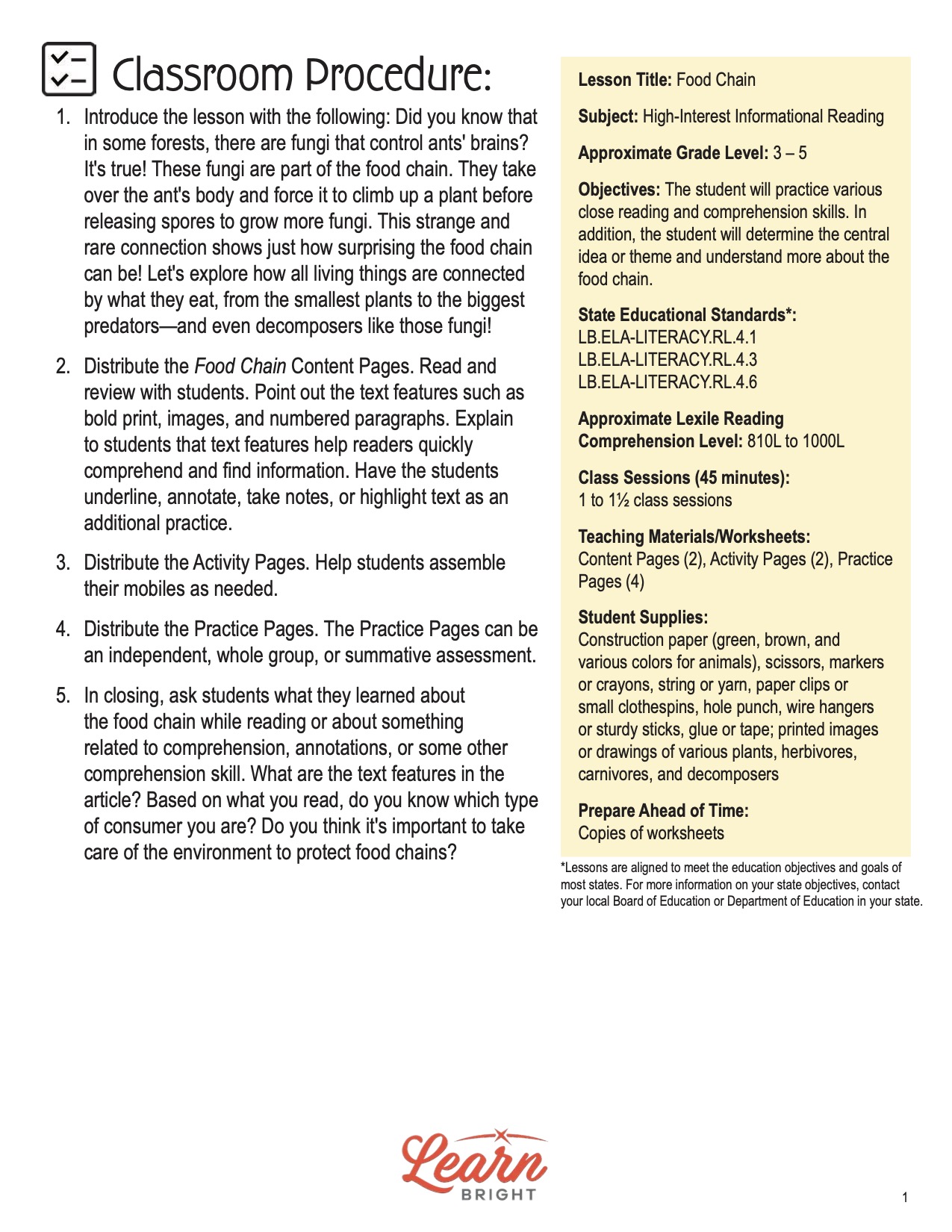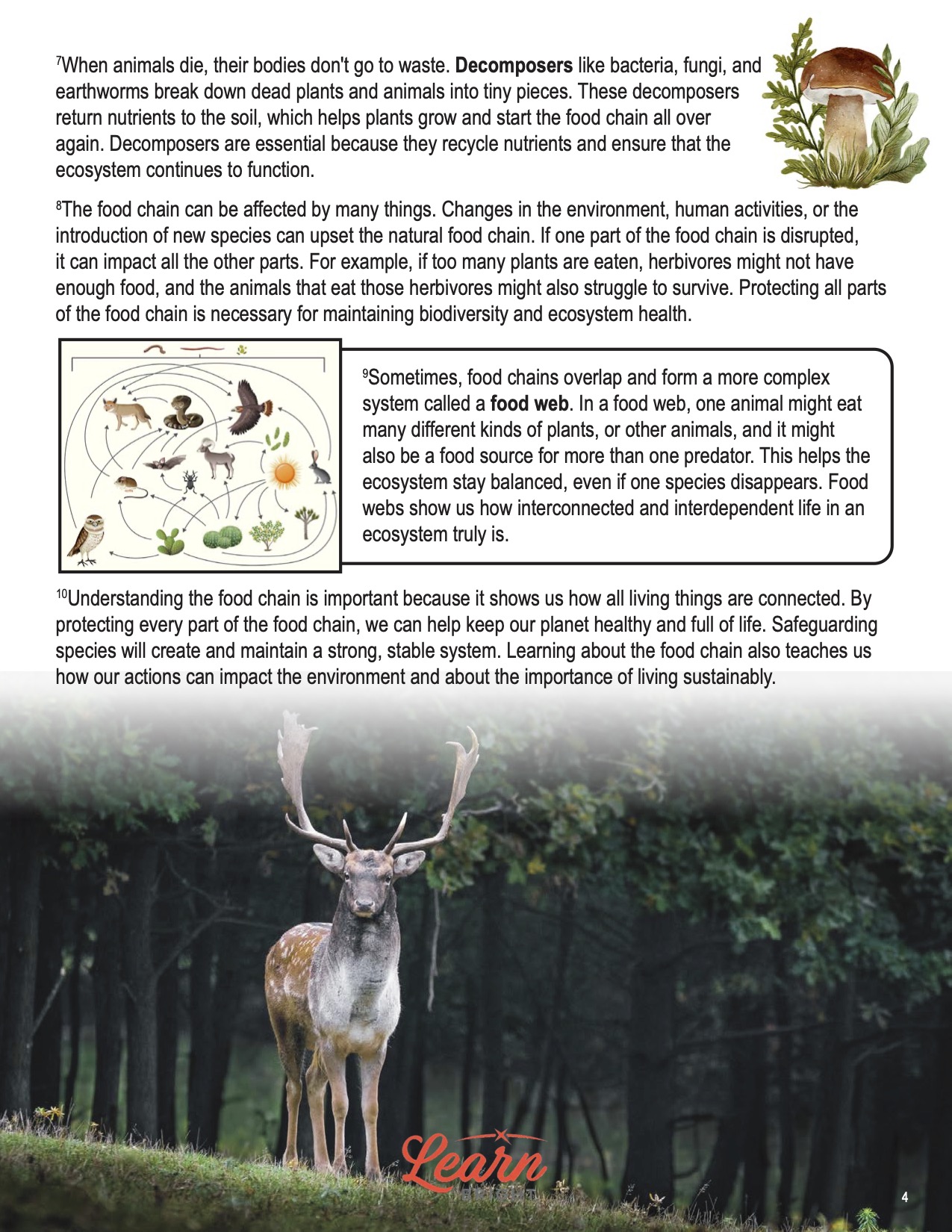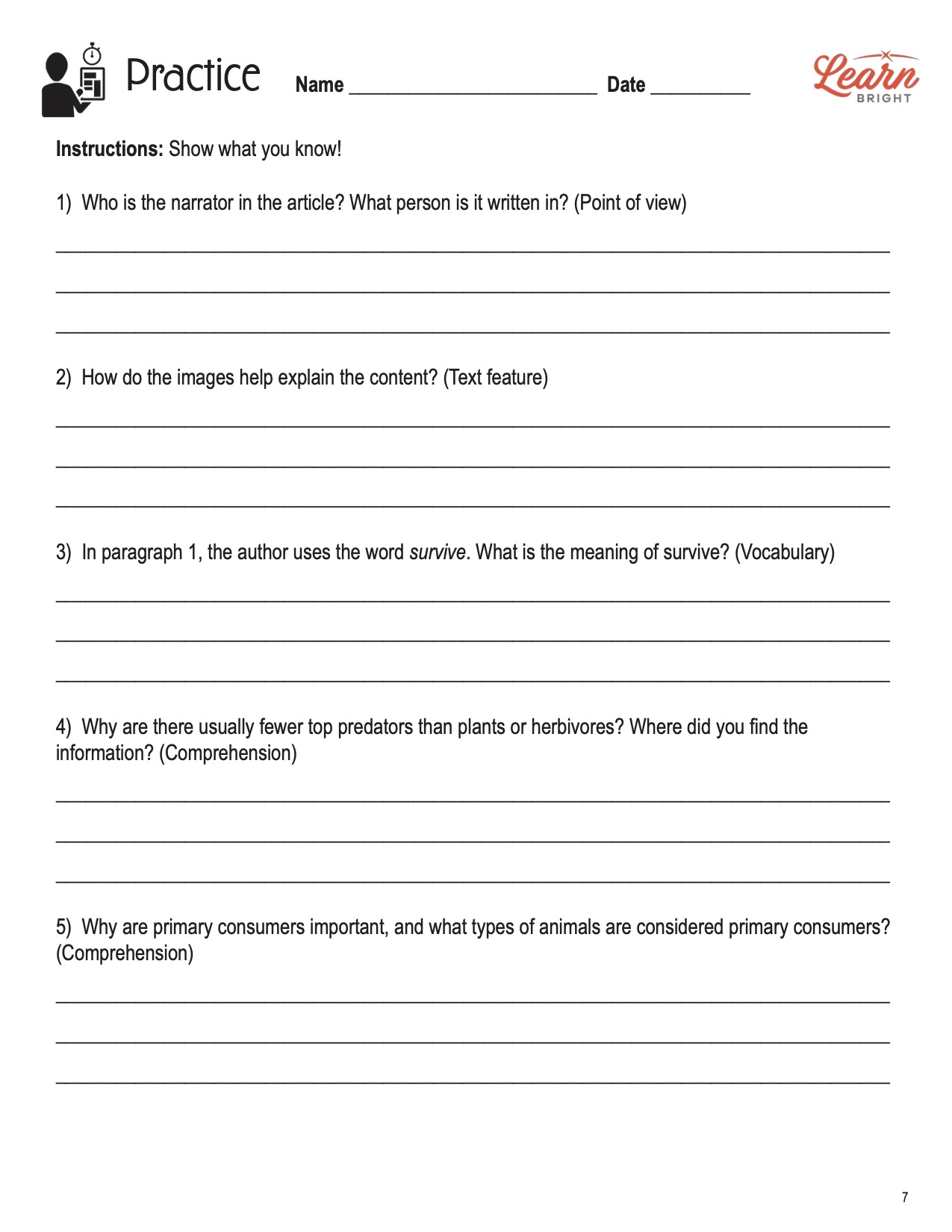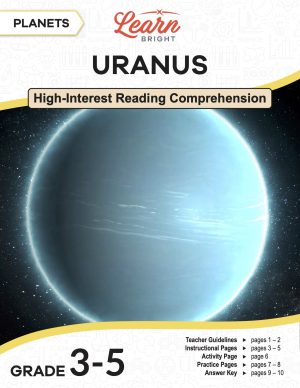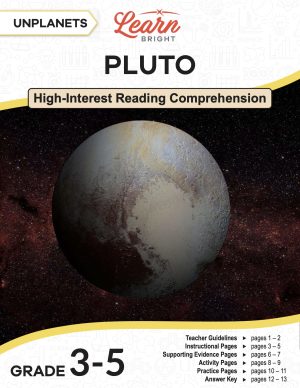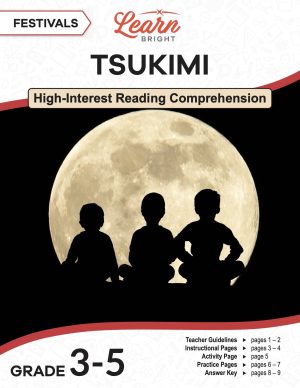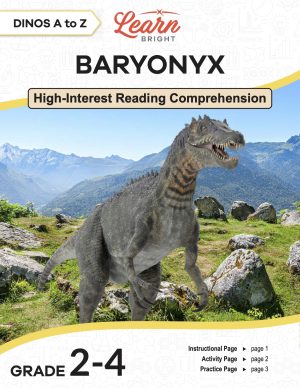Description
What our Food Chain lesson plan includes
Lesson Objectives and Overview: Food Chain is a high-interest reading lesson plan. As such, students will practice various close reading and comprehension skills. In addition, they will determine the central idea or theme of the article and understand more about the food chain.
Classroom Procedure
Every lesson plan provides you with a classroom procedure page that outlines a step-by-step guide to follow. You do not have to follow the guide exactly. The guide helps you organize the lesson and details when to hand out worksheets. It also lists information in the yellow box that you might find useful. You will find the lesson objectives, state standards, and number of class sessions the lesson should take to complete in this area. In addition, it describes the supplies you will need as well as what and how you need to prepare beforehand. The extra supplies you will need for this lesson include hole punch, wire hangers, glue or tape, and other materials. Check the “Student Supplies” section for the full list.
Teacher Notes
The paragraph on this page gives you a little more information on the lesson overall and describes what you may want to focus your teaching on. It explains that you can teach this lesson in a whole-class setting or as an independent, small-group activity. The blank lines are available for you to write out any thoughts or ideas you have as you prepare.
FOOD CHAIN LESSON PLAN CONTENT PAGES
The Food Chain lesson plan includes two pages of content. In nature, all living things are connected through something called the food chain. The food chain shows how energy moves from one organism to another. Every living thing needs energy to survive, and that energy comes from food. The food chain helps us understand who eats whom in the wild, and it also shows how energy flows from one level to the next.
Produces and Primary Consumers
At the bottom of the food chain are the producers. Producers are usually plants and other organisms that make their own food through a process called photosynthesis. During photosynthesis, plants use sunlight, water, and carbon dioxide to make energy-rich food. They store the energy in their leaves, stems, and roots, which then become food for other animals. Without producers, there would be no energy available for the rest of the food chain.
Next in the food chain are the primary consumers. These are animals that eat plants, also known as herbivores. Herbivores, such as rabbits, deer, and caterpillars, rely on the energy stored in plants to grow and survive. By eating plants, they get the nutrients and energy they need to live. In this way, primary consumers play their important role in transferring energy from producers to higher levels in the food chain.
Secondary and Tertiary Consumers
After the primary consumers come the secondary consumers. These are animals that eat herbivores. They are usually carnivores (meat-eaters) like foxes, snakes, and birds of prey. Secondary consumers get their energy by eating herbivores and use it for hunting, growing, and reproducing. By controlling herbivore populations, secondary consumers help maintain the balance in ecosystems.
At the top of the food chain are the tertiary consumers. These animals are often the largest and strongest predators, such as lions, wolves, and eagles. Tertiary consumers eat other carnivores and sometimes herbivores too. Because some have no natural predators, they are often called apex predators. Apex predators help keep ecosystems healthy by preventing any one species from becoming too dominant. Some apex predators eat tertiary consumers, making them quaternary consumers!
Every time an animal eats another, energy is passed along, but not all the energy is transferred. Some energy is lost in the form of heat or used up by the animal to stay alive. This is why food chains are usually only a few levels long. The loss of energy at each level explains why there are fewer top predators than plants or herbivores.
Decomposers and Food Webs
When animals die, their bodies don’t go to waste. Decomposers like bacteria, fungi, and earthworms break down dead plants and animals into tiny pieces. These decomposers return nutrients to the soil, which helps plants grow and start the food chain all over again. Decomposers are essential because they recycle nutrients and ensure that the ecosystem continues to function.
The food chain can be affected by many things. Changes in the environment, human activities, or the introduction of new species can upset the natural food chain. If one part of the food chain is disrupted, it can impact all the other parts. For example, if too many plants are eaten, herbivores might not have enough food, and the animals that eat those herbivores might also struggle to survive. Protecting all parts of the food chain is necessary for maintaining biodiversity and ecosystem health.
Sometimes, food chains overlap and form a more complex system called a food web. In a food web, one animal might eat many different kinds of plants, or other animals, and it might also be a food source for more than one predator. This helps the ecosystem stay balanced, even if one species disappears. Food webs show us how interconnected and interdependent life in an ecosystem truly is.
Understanding the food chain is important because it shows us how all living things are connected. By protecting every part of the food chain, we can help keep our planet healthy and full of life. Safeguarding species will create and maintain a strong, stable system. Learning about the food chain also teaches us how our actions can impact the environment and about the importance of living sustainably.
FOOD CHAIN LESSON PLAN WORKSHEETS
The Food Chain lesson plan includes three worksheets: an activity worksheet, a practice worksheet, and a homework assignment. Each one helps reinforce students’ understanding of the material they learned about. You can refer to the classroom procedure guidelines to know when to hand out each worksheet.
FOOD CHAIN MOBILE ACTIVITY WORKSHEET
For the activity, students will create a food chain mobile by following the steps on the worksheet page. When they are done, they will answer a series of reflection questions on the second activity worksheet page.
REVIEW PRACTICE WORKSHEET
The practice worksheet lists 10 questions based on the content. These questions all relate to the content pages, so students will need to refer to them often for the answers. In addition, each question provides which reading tool the question corresponds to, such as text feature, vocabulary, or comprehension.
Worksheet Answer Keys
The final few pages of the lesson plan are answer keys for worksheets. The answer key for the activity lists the organisms under the correct label. It also lists the applicable roles each consumer plays. The practice worksheet answer key shows the correct answers in red. For the homework, students’ responses will vary. You will have to check student by student to ensure their answers reflect the foods they consume. If you choose to administer the lesson pages to your students via PDF, you will need to save a new file that omits these pages. Otherwise, you can simply print out the applicable pages and keep these as reference for yourself when grading assignments.

